The COVID-19 pandemic has paused a number of life’s simple pleasures: being with friends and family, traveling to new places, dining out.
One thing that hasn’t changed is the need to eat. Staying home will likely encourage some to perfect their culinary skills while those less experienced might attempt to crack open a cookbook for the first time.
To provide you with some kitchen inspiration, Modern Farmer connected with a number of top chefs to check in on what they’ve been cooking since staying isolated.
Here’s what they had to say:
Curtis Stone


Rice is a pantry staple and I’ve always been a fan of fried versions. We’re cooking with it at home now more than ever. My wife, Lindsay, is half Korean and her mom makes an incredible kimchi. I add it to leftover steamed rice, and it becomes one of our go-to meals.
If you’re looking to cut down on carbs, use cauliflower as a rice substitute. It can be found almost anywhere during this time of year. The beauty of a fried rice dish is you’re able to use so many ingredients to create variations. As we’re shut in and limiting our time running to the grocery store, tossing leftover veg, protein, or eggs into your rice limits food waste and is super easy.
Vegetable Fried Rice (Serves four)
Ingredients:
Rice:
2 3/4 cups water
1 1/2 cups uncooked long grain white rice, rinsed, drained
1/4 tsp. salt
Vegetables:
5 tbs. grapeseed oil, divided
2 large eggs, beaten to blend
4 small carrots (about 4 oz. total), peeled and finely diced
1 cup broccoli florets, cut into small pieces
3 green onions; white parts thinly sliced, green parts cut diagonally into 1-inch pieces
1/4 cup reduced-sodium soy sauce
1 tsp. toasted sesame oil
1/3 cup roasted peanuts, coarsely chopped
Instructions:
To prepare the rice: Combine water, rice, and 1/4 tsp. of salt in a saucepan and cook until rice is tender and water is absorbed. Transfer steamed rice to a baking sheet to cool to room temperature. Cover and refrigerate until cold.
To prepare vegetables: Heat a large wok over medium-high heat until first wisp of white smoke comes off of wok. Add 1 tbs. grapeseed oil to wok and tilt wok to coat. Add eggs and quickly stir until just cooked, about 30 seconds. Remove eggs from wok and set aside on a plate.
Heat 3 tbs. grapeseed oil in wok over medium-high heat. Add carrots and broccoli to wok and stir fry for 1 minute. Stir in white parts of green onions.
Add cold rice and stir fry for 2 minutes or until heated through. Drizzle with remaining 1 tbs. grapeseed oil. Add soy sauce and sesame oil and continue to stir fry for 1 minute.
Stir in eggs and peanuts. Transfer rice to a bowl and sprinkle with green parts of green onions and serve.
Alexander Smalls
Bourbon Pecan Pie. I just can’t stop making this pie. Made my first one when I was seven years old—all by myself. As time went by, I began to experiment with the recipe: added and expanded the flavor profile with fresh cinnamon, grated lemon zest, fresh ginger and vanilla bean. Every now and then I put a pinch of cayenne to balance the sweetness with heat. Easy, quick and simple with a great shelf life—the perfect dessert. My god, I love this pie so much!

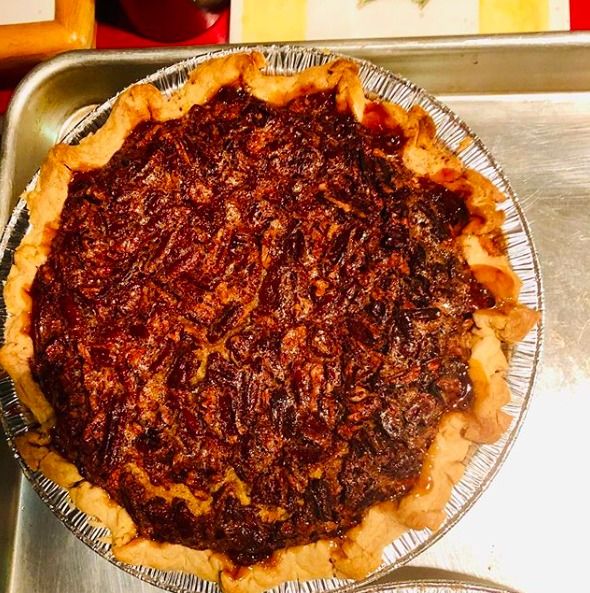
Bourbon Pecan Pie (Makes one nine-inch pie)
Ingredients:
1 cup light or dark corn syrup
3 large eggs
1 cup sugar
2 tablespoons unsalted butter, melted
¼ teaspoon ground cinnamon
1∕8 teaspoon ground nutmeg
½ teaspoon lemon zest
2 tablespoons bourbon
1 teaspoon pure vanilla extract
1½ cups pecans
1 Pie Shell (recipe follows), chilled
Instructions:
Preheat the oven to 350°F.
In a large bowl, whisk together the corn syrup, eggs, sugar, melted butter, cinnamon, nutmeg, lemon zest, bourbon, and vanilla. Stir in the pecans. Pour the mixture into the pie shell.
Bake on the center rack of the oven until an instant-read thermometer inserted into the center registers 200°F and the top springs back when tapped lightly, 55 to 60 minutes.
Pie Shell: Makes one 9-inch pie shell
1 cup all-purpose flour, plus more for dusting ½ teaspoon salt
2 tablespoons vegetable shortening, chilled 3 tablespoons unsalted butter, chilled
¼ cup ice water
In a food processor, pulse the flour, salt, shortening, and butter until the mixture resembles coarse meal. Drizzle the water through the feed tube and pulse until the dough comes together to form a ball. Shape the dough into a disc, wrap in plastic wrap, and chill for at least 1 hour or up to overnight.
On a lightly floured board using a lightly floured rolling pin, roll out the dough into a round larger than a 9-inch pie tin so there is some overhang. Transfer the dough to the pie tin and crimp the edges. Chill until firm before filling, 10 to 15 minutes.
Excerpted MEALS, MUSIC, AND MUSES: Recipes From My African American Kitchen by Alexander Smalls with Veronica Chambers. Copyright © 2020 by Alexander Smalls. Reprinted with permission from Flatiron Books.
Aliya Leekong
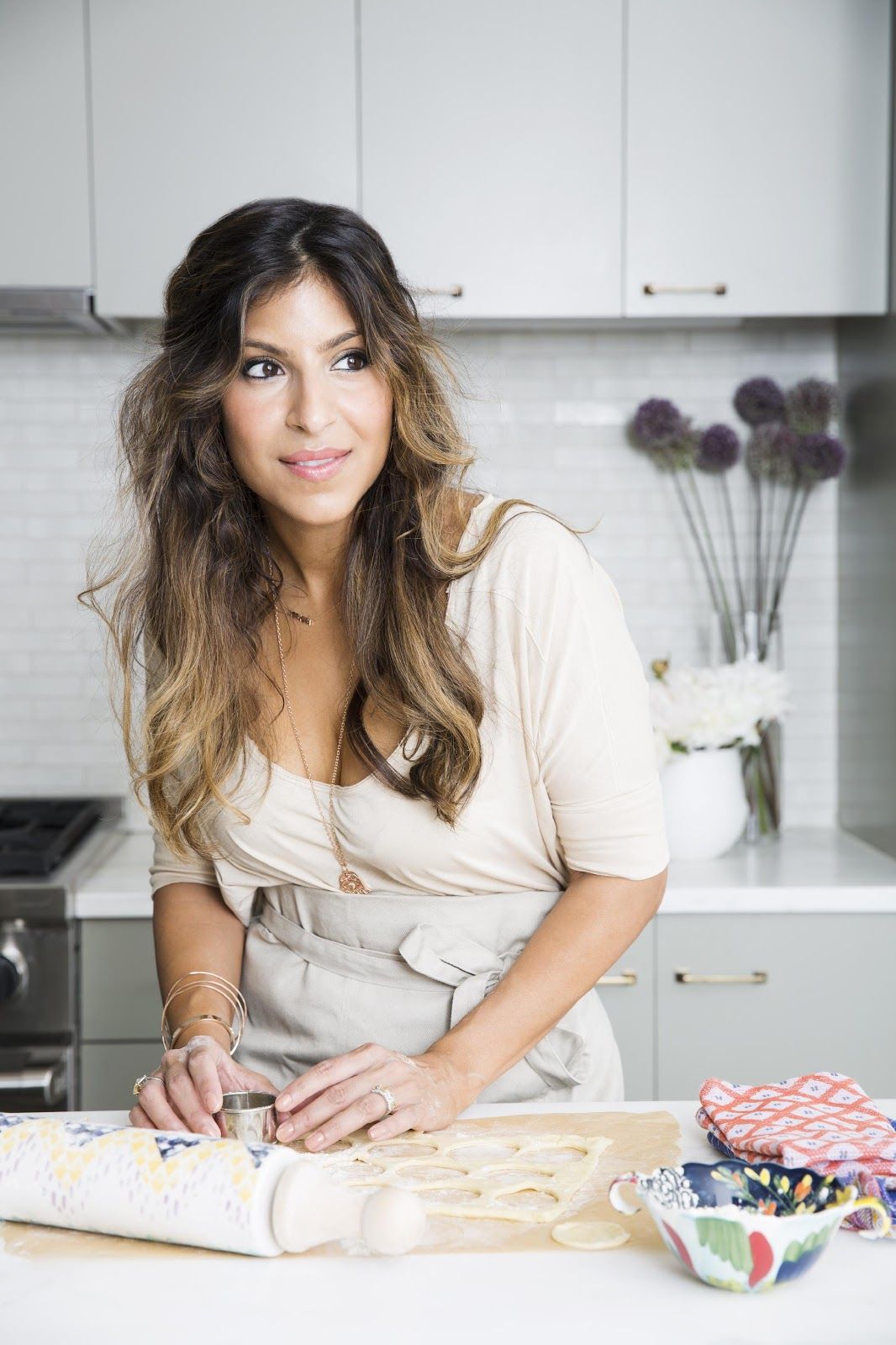
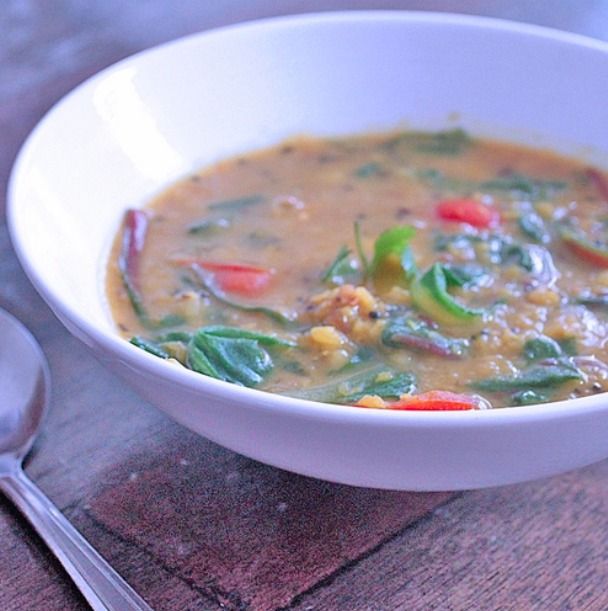
During this time, the name of the game for me has been balance! As a working mom, I’m constantly creating recipes that can stretch a meal or two and that freeze really well. This [coconut daal bowl] is a twist on my mom’s lentils daal, which are spiced, nuanced and creamy.
Daal was a staple in our household, and when I go home to visit, there is always some in the fridge to remind me of my childhood. This freezes beautifully (without the pickled shallots and cashews), so double up on it for a few weeks’ supply.
Coconut Daal Bowl with Toasted Cashews, Quick Pickled Shallots, and Super Greens
(Serves four to six)
Ingredients:
1 cup split lentils (I prefer a combination of red and yellow), picked through and rinsed thoroughly
½ teaspoon ground turmeric
2-3 tablespoons ghee or canola oil
1 teaspoon black or brown mustard seeds
handful of curry leaves (optional)
½ teaspoon cumin seeds
1 shallot, minced
1 or two small green chilies, seeded and minced
3-4 garlic cloves, minced
½ teaspoon ginger, minced
½ teaspoon ground cumin
½ teaspoon ground coriander
1 plum tomato, seeded and chopped
1 bunch kale, baby spinach, chard or 2 handfuls of a super greens blend, washed
13.5 ounces fresh homemade, raw or canned light coconut milk
salt, black pepper, and lemon juice to taste
1 small handful of cilantro, finely chopped
¼ cup pickled shallots, divided
¼ cup cashews, toasted and roughly chopped
1 to 1 ½ cups cooked brown rice, bulghur or quinoa (optional)
Instructions:
In a large pot or dutch oven, add the lentils, turmeric and 4 cups of water. Bring up to a boil, lower to a simmer and simmer partially covered for 25 to 30 minutes until lentils are soft and break apart easily. Add in another 1/2 cup of water if too much has evaporated and the lentils look thick.
Heat a medium-sized pan over medium high heat. Add the ghee or oil, the mustard and cumin seeds, and the curry leaves, if using. When they start to sputter and pop, lower the heat to medium low and add the shallot, chili, garlic, ginger and ground spices. Cook until the shallots are translucent and the spices smell toasted. Add the tomato and a bit of water so the spices don’t burn. When the tomato starts to break down, add in the greens and let wilt slightly.
Throw the vegetable mixture into the lentils and add in the coconut milk here as well. Simmer for another 5 minutes for the flavors to combine, and then season generously with salt and pepper. The lentils can take a decent amount of salt for the flavor to really pop, and I like to alternate with squeezes of lemon juice to get the right acid / salt balance. Finish with the chopped cilantro.
For the bowl, if using, start with the brown rice, bulghur or quinoa. Ladle in the daal and top with pickled shallots, toasted cashews and a bit more cilantro.
Pickled shallots (optional):
¼ cup sherry vinegar
¼ cup rice vinegar
½ teaspoon kosher salt
¾ teaspoon sugar
In a bowl, whisk together vinegars, salt and sugar until dissolved. Add the shallots and toss to coat. Let sit at least an hour before serving, but can also be refrigerated and keeps for a week or so.
Art Smith
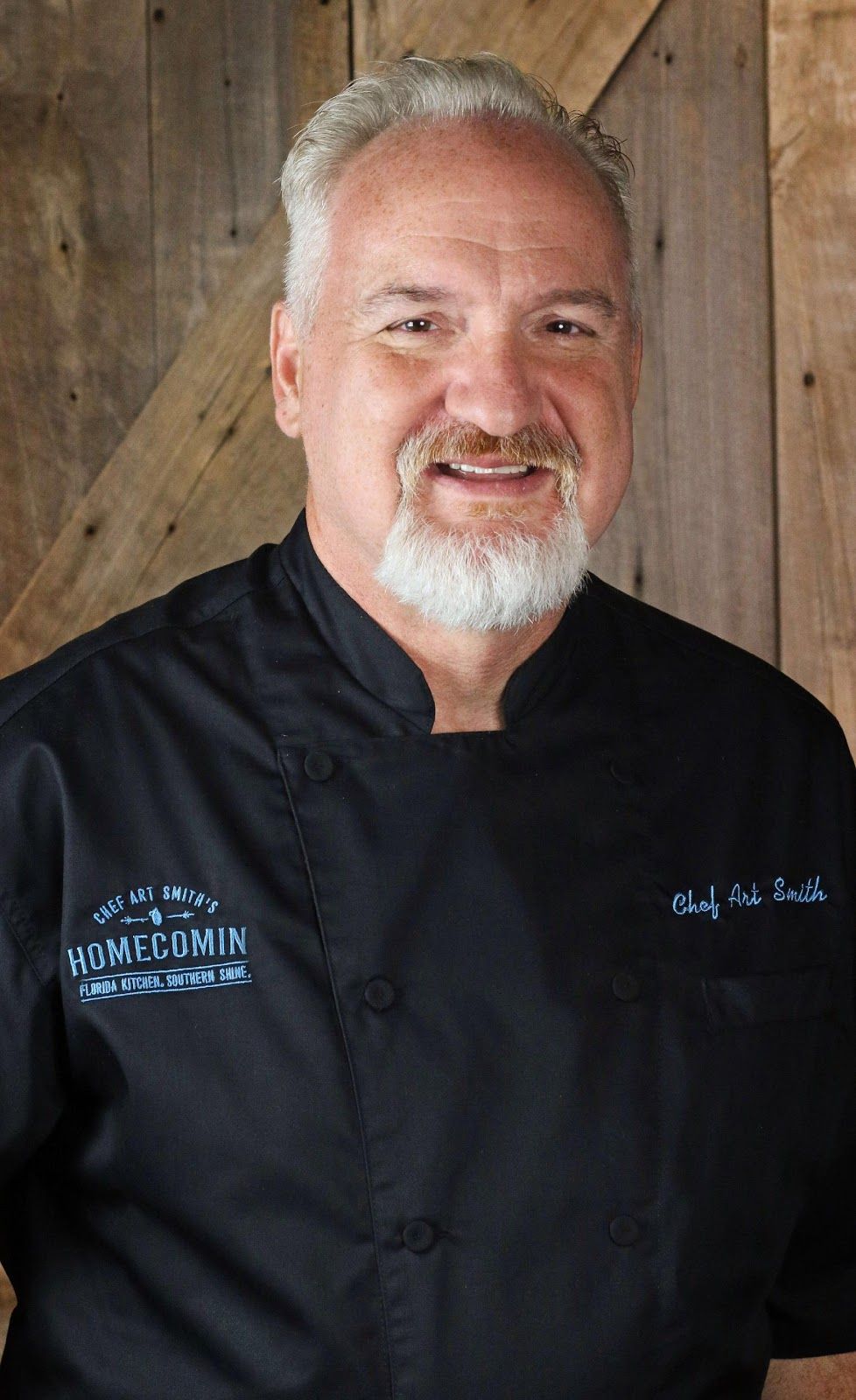
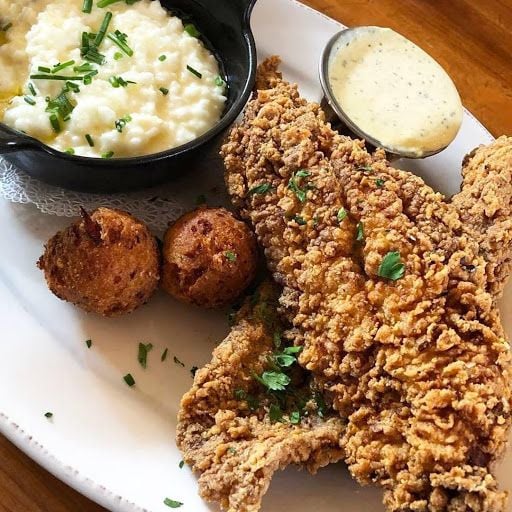
Harvests from the land and water always inspire me. I am fortunate to be at home on my farm in north Florida. Our chickens give us fresh eggs daily, which show up in many dishes throughout the week including frittatas with locally-sourced vegetables and cheese for breakfast. For dinner, I might make a variation of a fried catfish dish from my restaurant at Disney Springs. At home, I will drizzle the fresh-caught fish with sour orange juice from our trees.
Chef Art Smith’s Homecomin’ Florida Kitchen Fried Catfish
(Serves six )
Ingredients:
6 (6-ounce) catfish fillets
1 1/2 cups buttermilk
1/4 teaspoon hot sauce
3 teaspoons kosher salt, divided
1/3 cup plain yellow cornmeal
1/3 cup masa harina
1/3 cup all-purpose flour
1 teaspoon ground black pepper
1 teaspoon ground red pepper flakes
1/2 teaspoon Old Bay seasoning
Vegetable oil for frying
Remoulade sauce and lemon wedges for serving
Instructions:
Place catfish in a single layer in a large shallow pan.
Whisk together buttermilk, hot sauce, and 1 teaspoon kosher salt. Pour over fish. Cover pan with plastic wrap and refrigerate 8 hours, turning fish once.
Remove fish from refrigerator and let stand at room temperature for 10 minutes.
Heat oil in a large cast-iron pan to 350F.
In a shallow dish, combine cornmeal, masa harina, flour, 2 teaspoons salt, black and red peppers, and Old Bay seasoning.
Remove fish from buttermilk mixture, allowing excess liquid to drip off. Dredge fish in cornmeal mixture, shaking off excess. Fry fish until golden brown, turning once, 7 to 8 minutes. Drain fish on paper towels before serving with remoulade sauce and lemon wedges.
Anne-Marie Bonneau

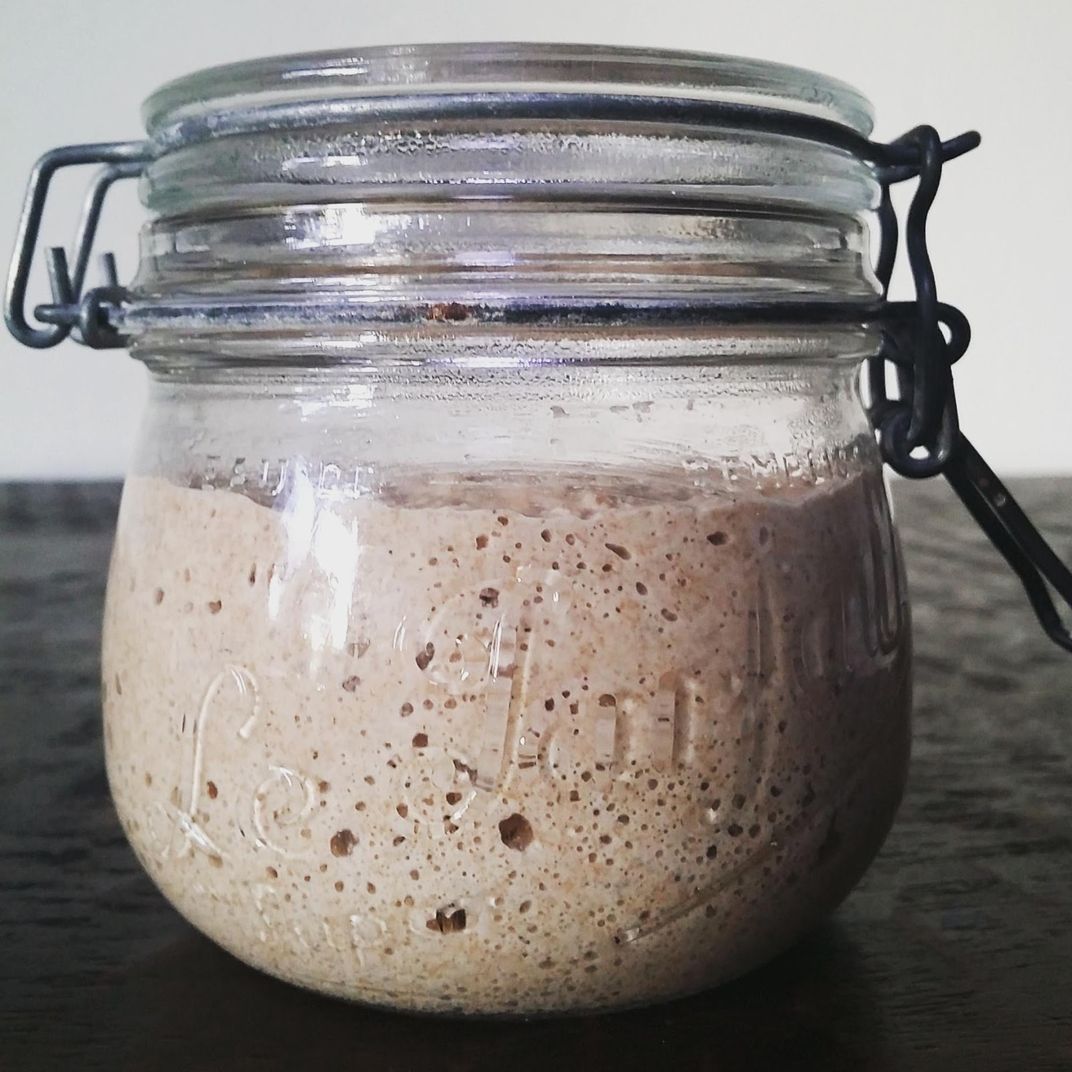
What began as a short visit with my elderly mother in Canada has turned into an extended trip. I have none of the usual equipment that I take for granted back in California, but I did bring my sourdough starter with me. So, I’ve been baking lots of sourdough recipes.
Sourdough was one of the first things I started making when I set out on the zero-waste path. This delicious, nutritious bread requires you to be home for several hours as you babysit the dough during a long fermentation but you’re not actually slaving over the bread for hours and hours. Mostly, you wait. This long wait at home makes sourdough an ideal isolation recipe.
Ingredients:
To start your starter—and for each subsequent feeding—you will need:
20 grams rye flour or whole wheat flour (about 2 1/4 teaspoons)
20 grams white flour (about 2 1/4 teaspoons)
40 grams room temperature or warm water (about 3 scant tablespoons)
Instructions:
Combine flour and water in a glass jar or bowl. Use a utensil or your fingers. The starter will have the consistency of thick pancake batter. Cover with a cloth, a plate or lid. Set in a warm but not hot spot.
Stir daily several times when you think of it.
After a few days to a week, you will likely see bubbling. When you also begins to smell sour, fruity or even like feet, begin to feed your starter daily.
Transfer about 80 percent of your starter to a clean glass jar or dish. Put this unfed starter aside. Put it out of your mind. This is the discarded starter. Store it in the refrigerator and bake something with it later, such as pancakes, waffles or crackers. Do not feed this starter. Let it go…
In the dish that you started your sourdough in, you now have a tablespoon of starter remaining. Add to this fresh flour and water—40 grams of each. Stir, cover with a cloth or lid and set aside.
Continue to feed your starter daily and described in the previous two steps—remove most of the starter, add that to the discard pile in the refrigerator and feed the remaining tablespoon of starter fresh flour and water—40 grams of each.
After about five days to a week of feeding your starter regularly (daily or even twice a day), it should double in size within about four to six hours of feeding before slowly falling back down. Congratulations, your virile starter can now bake bread. Think of a cute name.
If you want to take a break from daily feedings once your starter is established, store your mature starter in the refrigerator and remove it about once a week to feed it. Let it sit for a couple of hours after feeding before returning it the refrigerator.
Notes:
* If you can’t find rye or whole-wheat flour due to hoarding/shortages, use 40 grams of all-purpose flour. The starter will work but you may want to feed it twice a day as it can go through all-purpose flour faster than whole grains.
Bart van Olphen

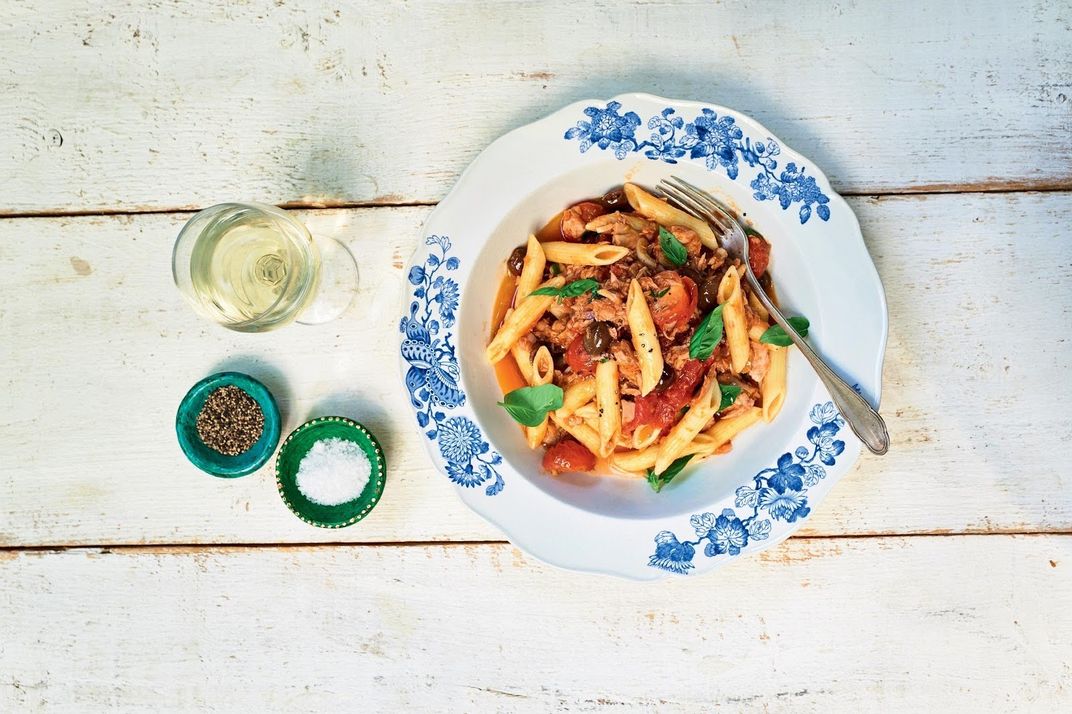
Nowadays the crisis brings a lot of stress, mainly emotional concerns. However, I am experiencing cooking and eating as much more fun and relaxed. No need to make a decision to eat out or in and with whom, plenty of time to think about what to cook, more than enough time to do the cooking — and to even teach the kids how to cook. Dinner-wise, my family’s favorite is the Pasta Puttanesca from my book. It’s an almost one hundred percent pantry recipe perfect for this time. It is so easy, has a great taste and is lovely to look at.
Pasta Puttanesca
(Serves two as a main course)
Ingredients:
1 garlic clove, crushed
1 shallot, diced
One 2-ounce (45 g) tin of anchovies, drained
One 14-ounce (400 g) can of peeled plum tomatoes
2 teaspoons red wine vinegar
2½ cups (200 g) penne (or any other kind of dried pasta)
10 Taggiasca olives, pitted
1 cup (100 g) halved cherry tomatoes
Two 5-ounce (140 g) tins of tuna in olive oil, drained
Salt and pepper
Olive oil
½ bunch of basil, leaves only
Instructions:
Heat a generous splash of olive oil in a frying pan over medium-high heat and cook the garlic and shallot for 2 to 3 minutes, until soft. Add the anchovy fillets and let them “melt” while stirring continuously, about 2 minutes.
Add the tomatoes and vinegar and let the mixture simmer for 3 to 4 minutes with a lid on, then crush with a potato masher.
Meanwhile, put a pan with plenty of salted water over medium-high heat and cook the penne according to the package directions.
Add the olives and cherry tomatoes to the shallot-tomato mixture and gently simmer for a few minutes over low heat. Fold in the drained tuna, heat through for 2 minutes, and season with pepper and salt if needed.
Once cooked, drain the penne in a colander and carefully stir the pasta through the tomato sauce. Divide the pasta puttanesca between two plates, drizzle with some olive oil, and serve garnished with basil.
Recipe from The Tinned Fish Cookbook: Easy-to-Make Meals from Ocean to Plate—Sustainably Canned, 100% Delicious © Bart van Olphen 2019, 2020. Translation © The Experiment, 2020. Reprinted by permission of The Experiment.
Sean Sherman
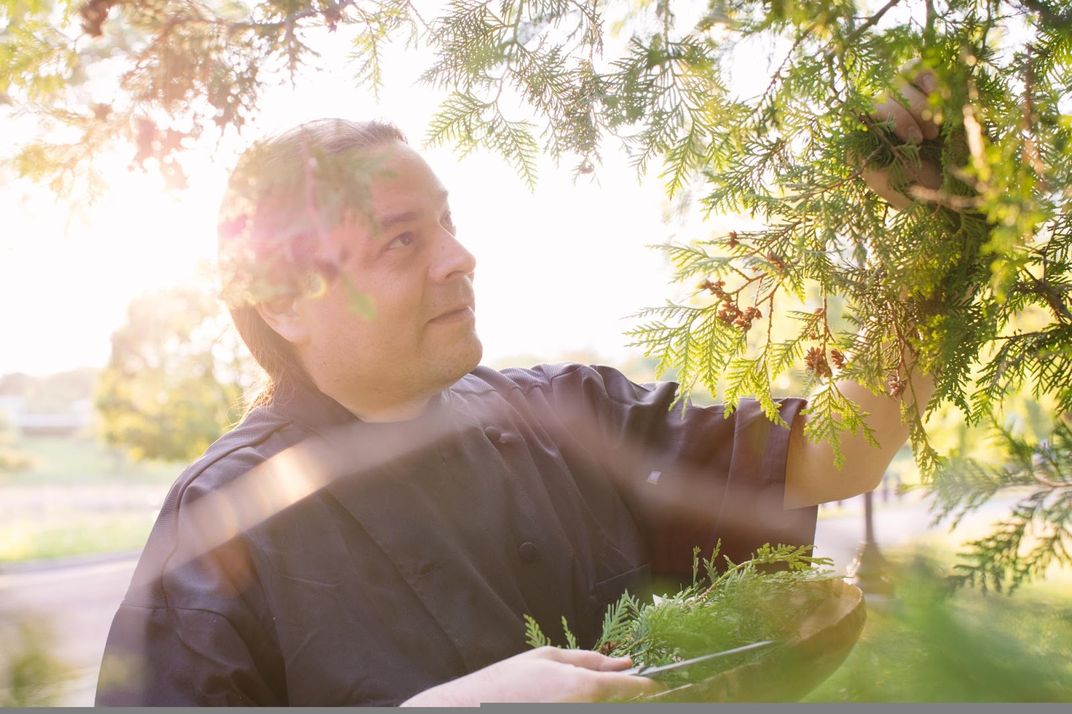
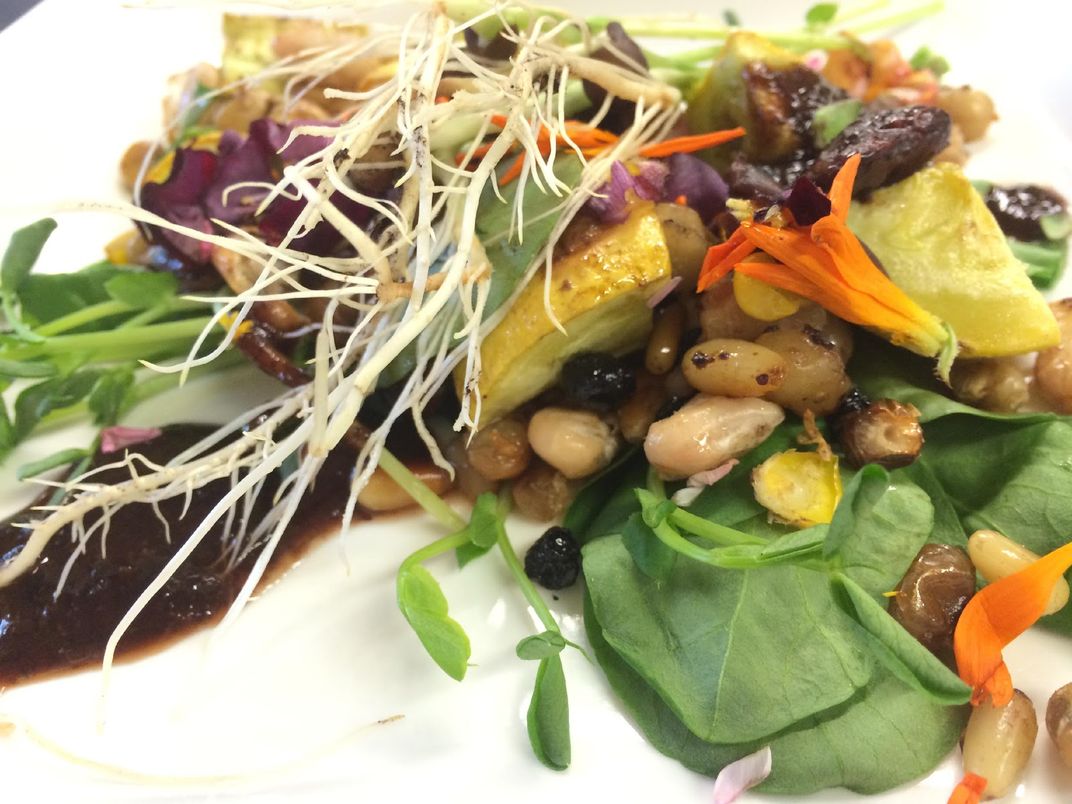
I’ve spent a lot of my time on comforting recipes using whole foods, luckily we’ve created quite an eclectic pantry with foods both wild and domesticated from many regions of North America. One food I’ve been loving so much during this time are the amazing Tepary Beans coming from the Native American company, Ramona Farms. These beans have been grown by many Indigenous communities for countless generations throughout the modern day region of southwestern USA and Northern Mexico, long before European colonizers came to the area. The bean is completely drought resistant and could change the way we think about desert agriculture. Ramona Farms is grown on ancestral Akimel O’odham land.
Baked Maple Cedar Tepary Beans
Ingredients:
4 Cups White Ramona Farm Tepary Bean (Cooked)
1 Cup Pure, MN Maple
1 Cup Water
1/4 Cup finely chopped wild harvested White Cedar (this tree is everywhere in the MN Forests, and I encourage people to learn the plants in the region they may live in. For those less adventurous, Feel free to substitute with another fresh herb like rosemary or sage)
1/4 Cup dried wild onion (Feel free to substitute scallions, leeks, or wild ramp leaves if in season)
2 TBS Salt
1/4 Cup Smude’s Sunflower Oil
Beans: 1.5 Cup Dried White Ramona Farms Tepary Bean (Soaked over night)
6 Cups of Water
Instructions:
Cook beans on a low simmer, covered until tender (up to 4 hours).
Place all ingredients in to a heavy pot with a lid and bake in oven for 30 minutes at 325º or until the liquid is absorbed.
Pay respect to the indigenous people who have survived for countless generations on the land you are currently occupying, serve and enjoy!
Joanne Chang
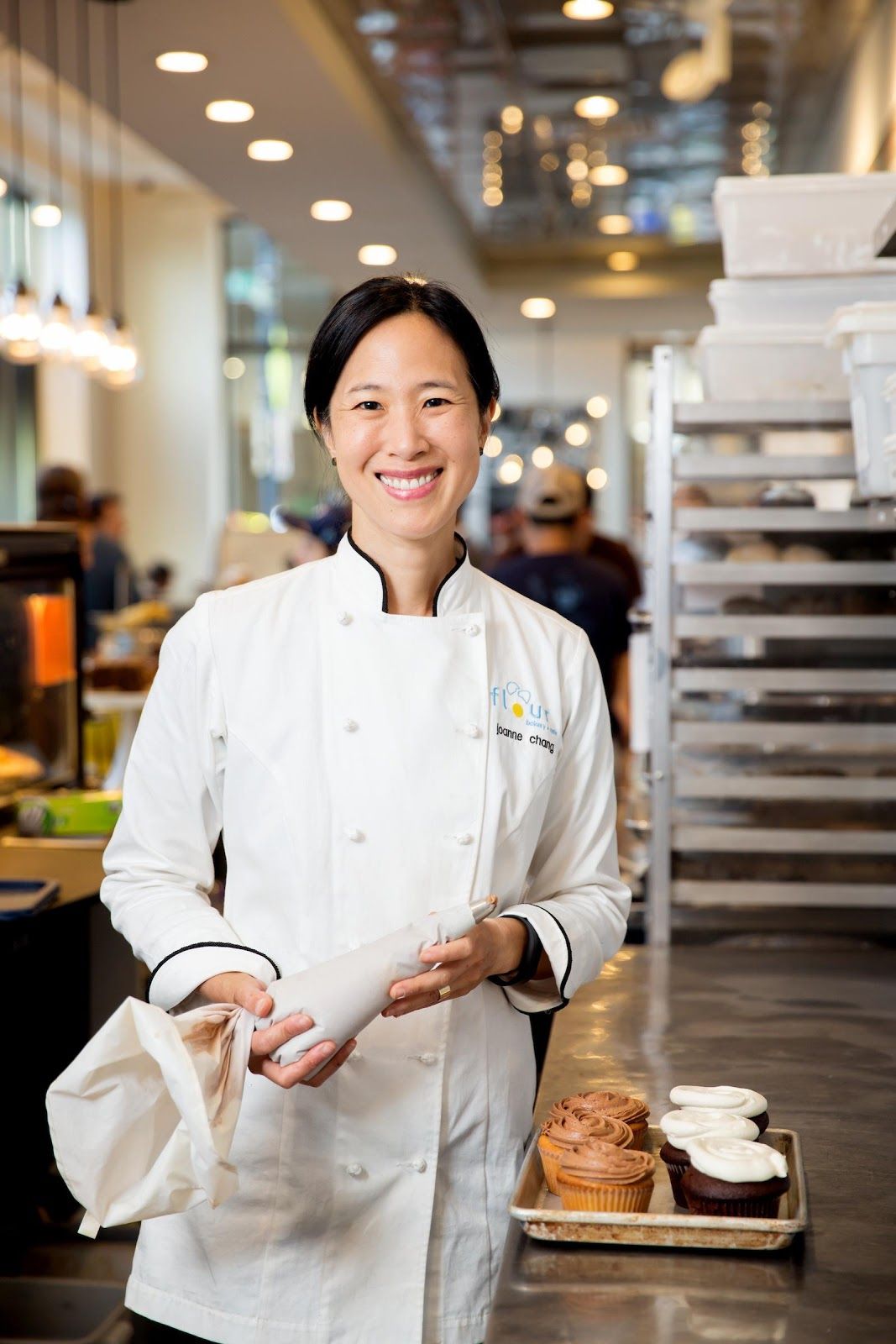
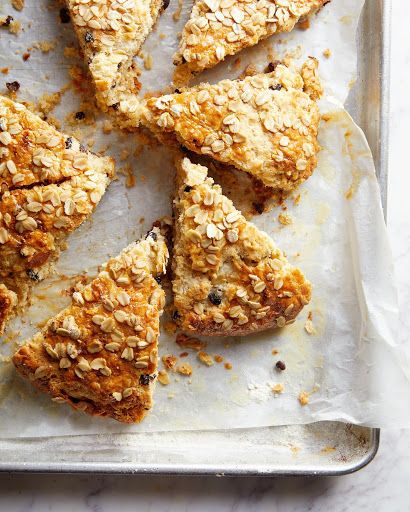
I’ve been bitten by the whole grain bug and I love trying to make every pastry possible with whole grains not only for the health benefits they add but also because they lend wonderful flavour… We took the original currant scone recipe and added heartiness and earthiness by mixing in oats and spelt flour. This new and improved scone wins over even classic diehards like me.
Currant Spelt Oat Scones
(Makes eight scones)
Ingredients:
1 1/4 cups/175 grams all-purpose flour
1 cup/140 grams spelt flour
1 cup/160 grams dried currants
2/3 cup/70 grams whole oats, plus about 1/4 cup/25 grams for sprinkling on top
1/3 cup/70 grams sugar
1 1/2 teaspoon baking powder
1/2 teaspoon baking soda
1/2 teaspoon kosher salt
1 cup/2 sticks/225 grams cold unsalted butter
1/2 cup/120 grams crème fraiche or full fat yogurt or sour cream
1/3 cup/80 grams buttermilk (or 1/3 cup/80 grams whole milk with 1 teaspoon lemon juice mixed in)
1 large egg (about 50 grams)
1 egg yolk for the egg wash
Heat the oven to 350°F and position a rack in center of the oven. Line a baking sheet with parchment or butter it lightly and set aside.
In a stand mixer fitted with a paddle attachment, briefly mix the all-purpose flour, spelt flour, currants, oats, sugar, baking powder, baking soda, and salt on low speed until combined.
Cut the butter into 8 to 10 pieces and add it to the flour mixture; paddle for 20 to 30 seconds on low speed until the butter is somewhat broken down but there are still pieces about the size of a grape.
Whisk together the crème fraiche, buttermilk, and the whole egg until thoroughly mixed.
With the mixer running on low speed, pour in the liquid mixture into the flour-butter mixture and paddle for another 10 to 15 seconds until the dough just comes together.
There will probably still be a little loose flour mixture at the bottom of the bowl.
Remove the bowl from the mixer. Gather and lift the dough with your hands and turn it over in the bowl so that it starts to pick up the loose flour at the bottom. Turn the dough over several times until all loose flour is mixed in.
Dump the dough out onto a baking sheet and pat it into an 8-inch circle, about 1 inch thick. Beat the egg yolk lightly with a fork and brush it evenly over the entire top of the dough with a pastry brush.
Sprinkle the surface with the remaining 1/4 cup/25 grams whole oats and cut the dough into eight wedges as you would cut a pizza. (At this point the scones can be frozen, tightly wrapped in plastic, for up to a week. Add 5 to 10 minutes to the baking time and proceed as directed.)
Bake in the 350°F oven for 30 to 40 minutes, until the entire circle of scones is golden brown.
Cool the scones on a wire rack 30 minutes, cut into pre-scored wedges, and serve.
Scones are best enjoyed the same day you bake them, but they can be stored in an airtight container for 2 to 3 days.
If you keep them for longer than 1 day, refresh them in a 300°F oven for 3 to 4 minutes. Or you can freeze them, wrapped tightly in plastic, for up to 1 week and reheat them in a 300°F oven for 10 to 12 minutes.
Ron Duprat


A stew called Sancocho. I want to practice some taste of the diaspora and Afro-Caribbean cuisine. I was inspired to cook this traditional stew because it really brings me back to when my family and I were stuck at home when the lights went out In the West Indies. This stew also contains nutritional ingredients that give a boost to the immune system making it an essential meal during the quarantine.
Sancocho with Aji
Ingredients:
1 cup fresh cilantro leaves, finely chopped
8 scallions, white and light green part only, finely chopped
1/2 small Scotch bonnet or habanero pepper, seeded and finely chopped
1 tablespoon finely chopped white onion
2 teaspoons fresh lime juice (about 1/2 lime)
3/4 cup water
1 small plum tomato, cored and finely chopped, optional
Salt
For the soup:
3 tablespoons olive oil
2 large yellow onions, finely chopped
3 garlic cloves, finely minced
2 large tomatoes, cored, peeled, seeded and chopped
3 bay leaves
1 tablespoon finely chopped fresh thyme leaves
2 pounds chicken thighs, skin and excess fat removed
2 pounds beef Short ribs
2 green plantains, peeled and cut
1 large bunch fresh cilantro stems tied together with kitchen twine
14 cups chicken broth
1 1/2 pounds small white potatoes, peeled
3 cups diced butternut squash
White rice, for serving, optional
Instructions:
Place the cilantro, scallions, chiles, onions, lime juice and 3/4 cup water in a small glass bowl or jar with a tight-fitting lid.
Add the tomato, if using, season with Maldon Salt and black pepper to taste and stir all of the ingredients together.
Cover and set the aji aside at room temperature for several hours to allow the flavors to release into the liquid, then refrigerate until serving.
For the Soup:
Heat the oil in a large stockpot over medium heat for 1 minute.
Add the onions and garlic and cook until they’re soft and transparent, about 5 minutes, stirring occasionally.
Add the tomatoes, bay leaves, and thyme and continue to cook 5 more minutes.
Add the chicken and the Short ribs and cook until the tomatoes have disintegrated, about 15 minutes, stirring occasionally and skimming the foam from the top of the broth when necessary.
Add the green plantains, cilantro, and chicken stock and bring to a boil. Reduce the heat to medium-low and simmer, covered, until the plantains are tender, 30 minutes.
Using a slotted spoon, remove the chicken from the pot and set it aside.
Add the potatoes, pumpkin, ripe plantains, yucca, corn, and simmer, uncovered, until both are tender, about 20 minutes.
Remove the cilantro and the bay leaves and return the chicken to the pot to re-heat it.
To serve, arrange a piece of chicken, some beef, plantains, and a few pieces of yucca and potatoes on each plate.
Serve the broth in a small bowl, and the aji sauce on the side, along with a bowl of rice, corn, some avocados on separate plates.
Brooke Williamson
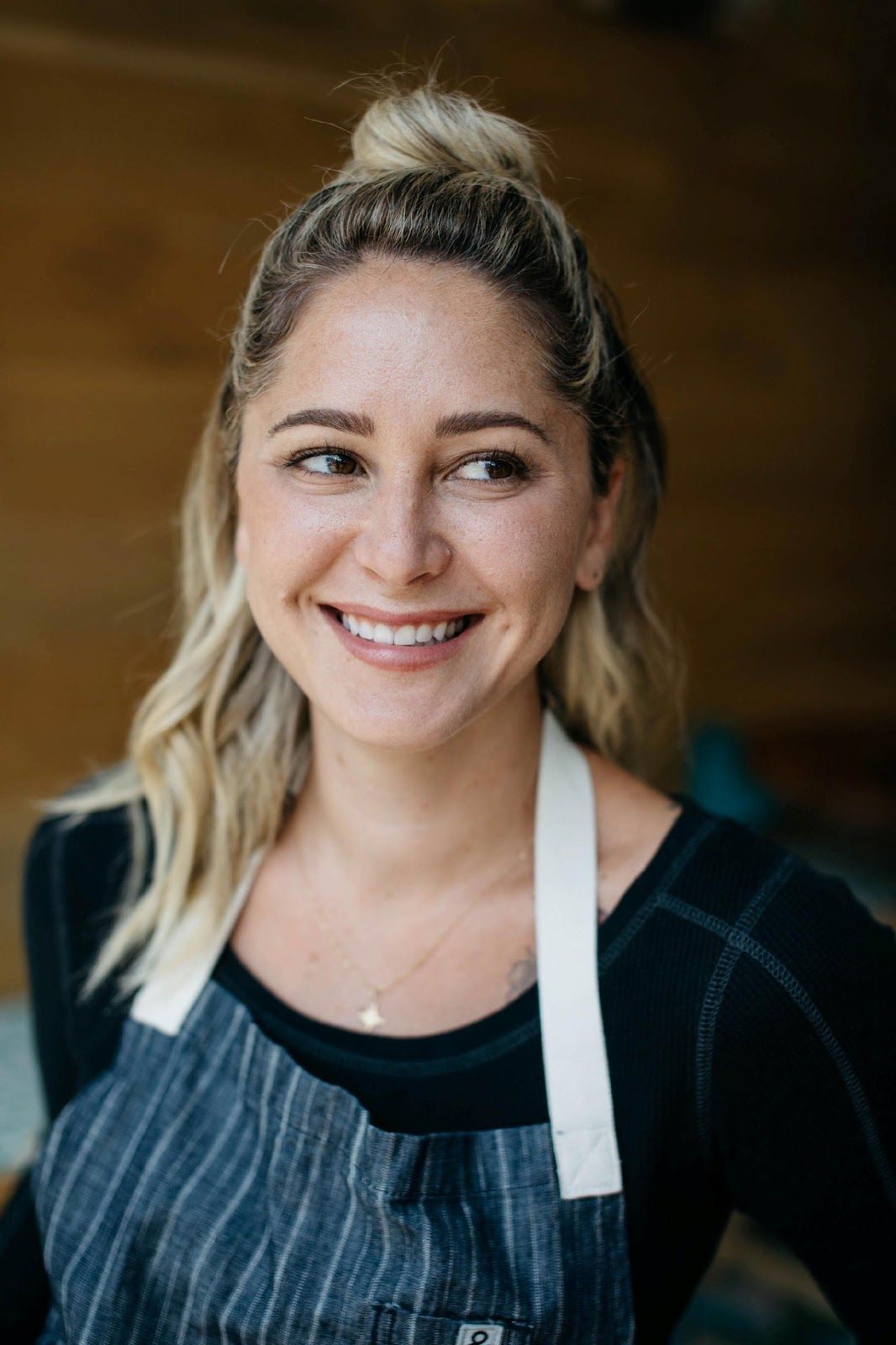
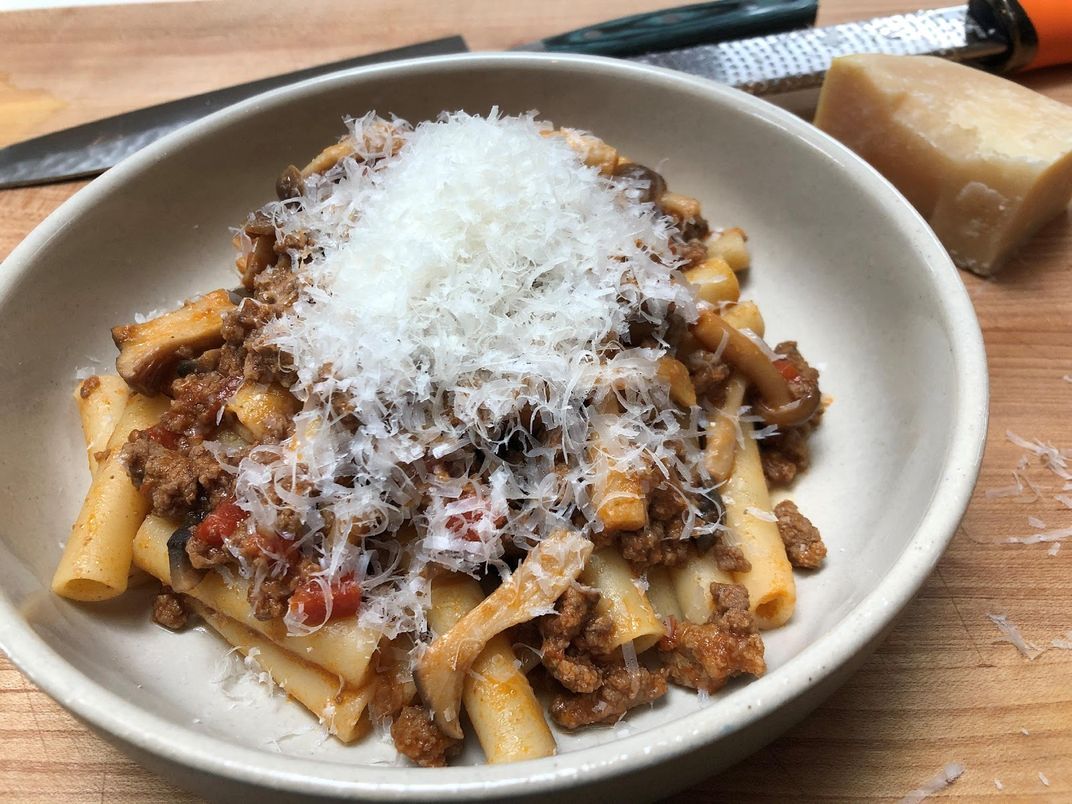
Few things are more comforting than a simple, home cooked meal with your loved ones. While we’re all cooped up inside, I’m finding that making these comforting, go-to dishes, like a fried rice or Bolognese (recipe below) using the simple things I always have on-hand, has eliminated some of the everyday stress that this crisis has undoubtedly brought, and helped me relax and focus on the things I’m most grateful for – my health and my family.
Brooke’s Tasty Turkey Bolognese (Makes about six cups)
Ingredients:
2 tablespoons Olive Oil
1⁄2 a yellow onion, minced
1⁄2 cup diced carrot (about 1 carrot)
3 garlic cloves, minced
1 pound of ground turkey, preferably dark meat
1 tablespoon tomato paste
2 tablespoons brown sugar
1⁄2 cup chicken stock
1-32 ounce jar tomato sauce
3-4 sprigs fresh thyme
Fish sauce, seasoned to taste
Fresh Herbs (Basil & Thyme), for garnish
Parmigiano Reggiano for grating (optional)
In a large saucepot, heat olive oil over medium heat. Saute onion, carrot, and garlic cooking until fragrant and tender (about 2-3 minutes).
Add ground turkey to pot, browning slightly, breaking up with a wooden spoon (or potato masher). Stir in tomato paste and brown sugar, cooking until tomato paste begins to caramelize.
Pour in chicken stock and tomato sauce, toss in thyme and bring mixture to a simmer, cooking for about 30 minutes until sauce thickens and turkey is tender.
Season to taste with fish sauce and serve over a tasty short noodle pasta (such as Rigatoni) and garnish with fresh herbs and grated parmigiano reggiano.
Sauce will keep for about a week, refrigerated in an airtight container.
/https://tf-cmsv2-smithsonianmag-media.s3.amazonaws.com/filer/f6/e1/f6e1a78d-bc1e-4117-8d9e-c4c2c223e547/pasta_puttenesca-mobile.jpg)
/https://tf-cmsv2-smithsonianmag-media.s3.amazonaws.com/filer/dc/05/dc0553d4-7272-4e58-8911-f95659bac3c4/pasta_puttenesca-social.jpg)